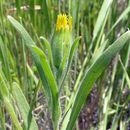Comments
provided by eFloras
Achyrachaena mollis grows in low-elevation grasslands, savannas, and open woodlands throughout the California Floristic Province and occurs with vernal tarweeds of the genus Layia. During flowering, pappus scales of each disc floret form cylinders (imparting a honeycomb-like appearance to apices of heads); they are widely spread in fruiting heads. The species is self-compatible and is not known to hybridize with other tarweeds.
- license
- cc-by-nc-sa-3.0
- copyright
- Missouri Botanical Garden, 4344 Shaw Boulevard, St. Louis, MO, 63110 USA
Description
provided by eFloras
Leaf blades 2–15 cm × 1–7+ mm. Phyllaries 10–20 mm. Ray corollas inconspicuous, laminae usually erect, sometimes spreading, 4–7 mm. Disc corollas 6–10 mm. Cypselae black, 4.5–9 mm; pappi (disc) of 5 outer scales 3–9 mm plus 5 inner scales 6–13 mm. 2n = 16.
- license
- cc-by-nc-sa-3.0
- copyright
- Missouri Botanical Garden, 4344 Shaw Boulevard, St. Louis, MO, 63110 USA
Brief Summary
provided by EOL authors
Achyrachaena mollis has a bioregional distribution that includes the California Floristic Province, southern Oregon and northern Baja California. Elevations of occurrence are on grasslands at generally less than 900 meters.
Known by the common name of blow wives, this annual can attain a height of three to 40 centimeters. The erect stem is erect and generally few-branched; the sessile leaves are simple, with lower ones opposite and fused around the stem; upper leaves are alternate. The linear of obtuse leaf blades are two to twelve centimeters long. Inflorescence is soft-hairy with radiate heads. Fruits are fine and slender, easily detached by wind when ripe, leading to a dazzling display of lightweight airborne fluff.

